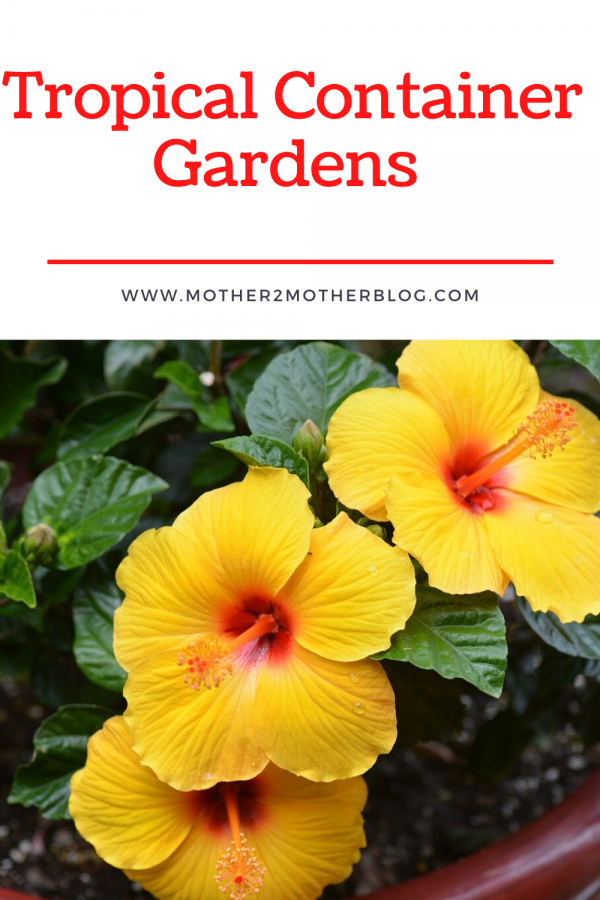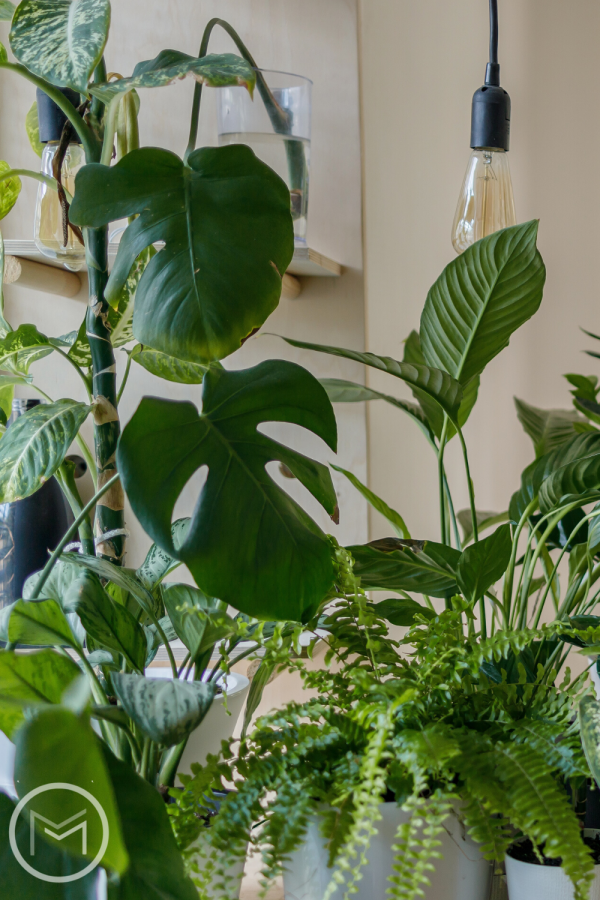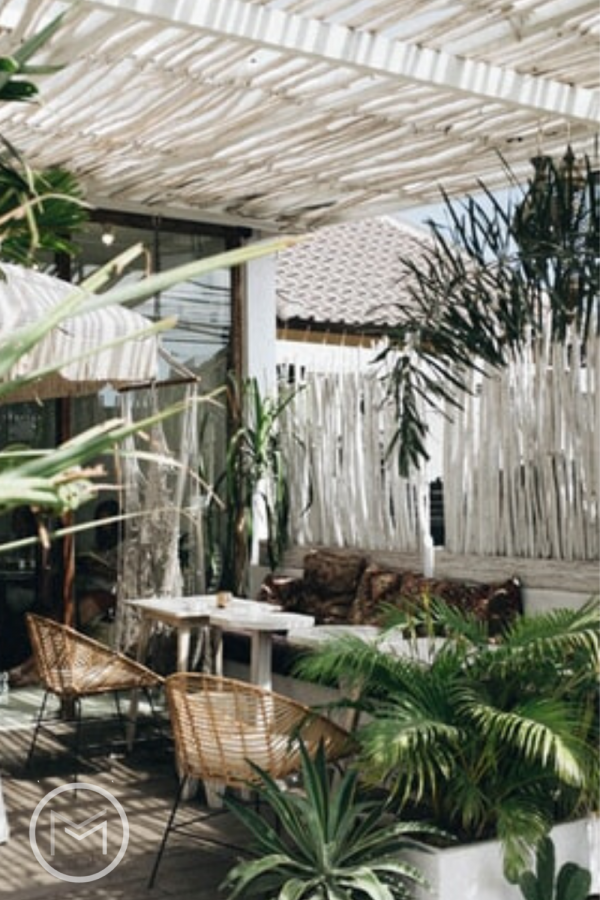Today, I’m sharing gardening tips on how to create tropical container gardens. You can transform your balcony, patio, garden or backyard into an exotic getaway. Using simple planters or containers and a variety of tropical plants can create an exciting new look. Dramatic annuals and decorative planters provide rich foliage and astonishing blooms. Furthermore, outdoor spaces can be transformed with little money and uses the trend toward container gardening. Lets get started with your transformation.

How to Create Tropical Container Gardens:
The Environment
- When people think of the tropics, their first thoughts are generally sun-kissed beaches with palm trees. But, that’s not the whole story. Most tropical plants come from the floor of the rainforest. They get little sun and have high levels of humidity. So, they don’t need as much sun as a cacti. And, tropical plants can live comfortably on balconies or shady backyards. As a matter of fact, tropical plants prefer indirect sunlight.
- Because tropical plants need high humidity, they require lots of watering. So, when using decorative planters they need to have good drainage. Choose planters with plenty of drainage holes to ensure the roots of the plants are free from standing water.
- There is one element tropical plants need less than other plants to help them grow, and that’s phosphorus. Look for fertilizers described as NPK on the label. These types have nitrogen, phosphorus, and potassium as the primary nutrients. Iron and magnesium will help sustain the bright colors of the tropical flowers. Plant food is recommended as well as adding Epsom salts to the soil at planting. This will give your plants a magnesium boost.
- Because the soil in planters and containers is above ground, it’s more exposed to heat and drying winds. As a result, it loses moisture more readily. This is especially true in a warm weather. So, tropical containers need to be monitored closely. It’s imperative that the humidity level around tropical plants not fall too low.Also, the soil should be moist but not soggy. Overwatering can cause rot and disease if the roots are allowed to stand in water for a long time. The soil in decorative planters should never be allowed to thoroughly dry out. If so, the sides will shrink. This gap means any water will pour through the container and not reach the roots. If this happens, push any soil that has shrunk from the edge around the pot to fill in the gaps before watering. One option to reduce evaporation, and maintain the humidity around the plant is to cover the surface with decorative mulch such as orchid bark.
Selecting a Planter or Container
With such a large variety of planters and containers to choose from, where do you start? Many gardens use the traditional terracotta clay pots. However, there are advantages and disadvantages for the tropical gardener. Terracotta pots are heavier than plastic or fiberglass pots and are easily chipped or broken. Most are more expensive too.
The style of the planter used for tropical container gardens are really a personal choice and the effect you want your tropical garden to project. The size of the containers will be limited by the space available, which will, in turn influence the size and plants they can accommodate.
Always try and buy brand new planters for tropical plants. Used pots may have been infected by disease or have chemical residues. If you do want to re-use planters make sure they are washed well. Wooden containers need to be lined with plastic, so the water and soil don’t cause them to rot.
If you don’t want your planter to become a water logged, make sure there are plenty of drainage holes in the bottom. Without these holes, the organic compost will become saturated with stagnant water and kill off your tropical plants.
Designing with Plants
Wherever you’re putting your tropical plants, you need to make the design look harmonious with the surroundings. You want to create an atmosphere you’ll be happy with. Think about what outdoor live plant displays you want the eye to focus on. Also, think about how the other plants flow around that the center plant. Each planter needs to have a balance of plants. You want the eye to go to the planter’s focal point. This can be accomplished with asymmetrical or symmetrical designs.
The form of the planter is dictated by the growth habit of the plants you put in it. Some plants like to grow tall, others like to hug the ground, and others want to flow over the edge of a planter. Each can be used to create an overall aesthetic for your tropical container gardens. And then there is texture, as the different types of foliage will give a different feel to a container. Broad leaves juxtaposed with linear leaves like grasses break up the eye line and bring a variation to your design. The best designs work on a variety of textures to add variance to the display. By repeat planting of the same plant in containers a rhythm is achieved. When looking at the planters admirers eyes can move from one planter to the other.
And, the final consideration when designing planters is proportion. There needs to be a balance of heights as well as plants. Garden designers have a rule that plants should not be higher than three times the height of the containers. For large and tall planters, medium to large plants with large leaves work well. And, for short and shallow planters smaller plants with small leaves and excellent coverage.

Shape, Texture, and Color
To get tropical container gardens or a garden planter to have a real exotic feel, you need to have plenty of tropical foliage. Most foliage will be green; however, you can break up the green with flowering annuals. There are lots of varieties that work well in planters such as, Vinca, Bacopa, Torenia, Verbena, Lantana, and Wax Begonia to name a few.
You can also break up the green foliage by using Caladium cultivars. They are available in a range of foliage shapes, sizes and colors. You can choose foliage colors that compliment the flowers or contrast. Think also about the texture of the foliage as some tropical plants have shiny leaves they can draw the eye easier to the highlighted plant in the container.
Designing a Planter
The central plant in tropical container gardens should fill the crown of the planter with compact upright growth. The filler plants are more compact and are there to round out the top of the planter. Allow corner plants to grow over the edges, and allow their growth in more than one direction. Plants place at the side of the container can soften the look, and fill out the space between the corners. When thinking about the plants you’ll put in each individual planter, pick those that have similar watering, feeding, and light requirements. It’s important that they all thrive in the chosen location.

Planter Location
We’re dealing with tropical plants, water retention is a prime consideration. Don’t put your tropical plants anywhere in your garden that is windy. The wind increases evaporation water evaporation. If you have a spot that gets anything from four to twelve hours of sun a day, you can use plants that like full sun or part shade. If the location gets only two to four hours of sun a day then you need to select plants that will accept whole or part shade. A lot of tropical plants can survive with varied light and will grow in the shade. However, this often means they will have reduced flowering.
Fertilizer
Tropical plants are pretty much like any other and like to get regular feeds a slow-release fertilizer in the soil and water with liquid fertilizer. Add a slow-release fertilizer at planting. Be sure to mix it thoroughly with the soil.
Maintenance
Like all gardens, tropical planters need to be maintained. It’s not just a matter of planting and forgetting. In the early stages to promote leaf growth, the plants will benefit from pinching, that’s the removal of young shoots. As the plant begins to grow, gentle trimming may be needed later in the season. As part of your watering regime, spraying with insecticidal soap or oil will keep pests and disease in check. Oh, and don’t forget the weeding!




